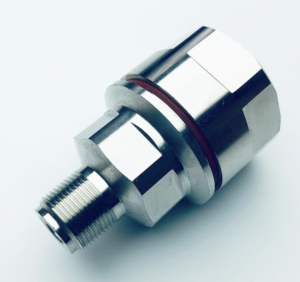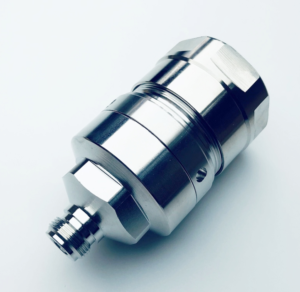Welcome to Jiexi Kunlian Cable Co.,Ltd , we will discuss some knowledge of feeder cable connectors
Introduction of connectors:
Feeder connector (connector) and conversion head (adapter)
1. Feeder connector (connector)
A detachable radio frequency connector is generally used for connection between the feeder and the equipment and different types of cables. Connectors are commonly known as joints.
Common RF connectors are as follows:
1. DIN type connector
The applicable frequency range is 0~11GHz, which is generally used for the radio frequency output port of macro base stations.
2. N type connector
The applicable frequency range is 0~11GHz, and it is used for small and medium power coaxial cable connectors with threaded connection mechanism.
This is the most widely used connector in indoor distribution. It has good mechanical properties and can be used with most feeders.
3. BNC/TNC connector
BNC connector
The applicable frequency range is 0~4GHz. It is a coaxial cable connector with bayonet connection mechanism for low power. This connector can be quickly connected and disconnected, has the characteristics of reliable connection, good vibration resistance, and convenient connection and separation. It is suitable for frequent connection and separation occasions and is widely used in radio equipment and test instruments to connect coaxial radio frequency cables.
TNC connector
The TNC connector is a modification of the BNC connector, which uses a threaded connection mechanism to connect coaxial cables in radio equipment and test instruments. The applicable frequency range is 0~11GHz.
4. SMA connector
The applicable frequency range is 0~18GHz. It is an ultra-small, suitable for semi-rigid or flexible radio frequency coaxial cable connection. It has the characteristics of small size, superior performance, high reliability, and long service life.
However, the ultra-small connectors are easily damaged in engineering and are suitable for microwave applications that require high performance, such as the internal connection of microwave equipment.
5. Inverted connector
Usually a pair of connectors: the male connector is connected by internal thread, the female connector is connected by external thread, but some connectors are opposite, that is, the male connector is connected by external thread, and the female connector is connected by internal thread. Collectively referred to as inverted connectors.
For example, the external antenna interface of some WLAN AP devices uses reverse SMA connectors.
2. Conversion head (adapter)
Our commonly used 1/2 feeder head is the N-type J head, also known as the N-J head
The commonly used 7/8 heads in the room divider are DIN-NJ heads, that is, the feeder end is DIN-sized and the output end is NJ head.
It should be a 1/2″ DIN male connector, said separately, the front is the feeder end, and the back is N and DIN.
The DIN header is used to connect to the base station, and is used when coupling the base station;
N head is divided into rooms.
Cables : There are mainly ordinary cables (8D, 1/2”, 1/2” super flexible, 7/8, 7/16”, 13/8”) and leaky cables (13/8”, 5/4”),
8D, 1/2″ super flexible, mainly used as a jumper, in some cases, bends in the complex area of the building structure.
In indoor distribution, 1/2″ and 7/8″ feeders are generally used for signal transmission. 7/16 base stations are used more often, and 13/8 is occasionally used as a backbone in large venues.
Leaky cables are generally used in tunnels.
Connectors : According to the wire diameter, it is divided into male and female heads, mainly J, K, N, D, etc., and SMA is also used in indoor distribution, which is the kind of small yellow color often seen on base stations and fiber optic equipment .
■Device name ◆Device model ●Unit ▲Alias
Connector Adapter 1/2-NJ type connector pcs male
Connector Adapter 7/8-NJ type connector pcs male
Connector Adapter 1/2-NK type connector pcs female
Connector Adapter 7/8-NK type connector pcs female
Connector Adapter NJKW Adapter One pcs Right Angle Adapter/Elbow
Connector Adapter N Type J-J Adapter pcs Unit Male to Male
Connector Adapter N Type K-K Adapter, pcs Female to Female
Connector Adapter NJ-DINJ type adapter pcs N male to DIN male
Connector adapter NJ-DINK type adapter pcs N male to DIN female
Load 10W-NJ type load
Flame-retardant feeder 1/2 feeder ordinary flame-retardant type meter
Flame-retardant feeder 7/8 feeder ordinary flame-retardant type meter
1/2″ feeder size: 1.27cm
7/8″ feeder size: 2.2225cm
13/8″ feeder size: 4.1275cm
(Note: 1″=1in=1inch=1inch=2.54cm=0.0254m)
a) The host/extension, antenna, coupler and power splitter interfaces are N-K sockets, and the feeder is N-J sockets;
b) When the feeder connector is connected to the main unit/extension, antenna, and coupler connector, the 50mm long feeder must be kept straight out from the feeder connector before turning;
c) When the feeder connector is connected to the host/extension, antenna, and coupler connectors, the connection must be reliable, and the connector must enter the wire smoothly and must not be savagely twisted.


